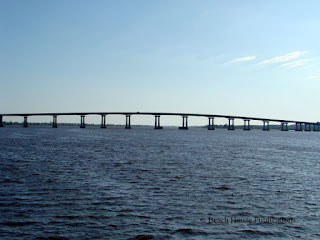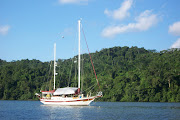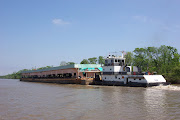From Carolina Beach, our next stop would be Mile Hammock Bay. Mile Hammock is another one of our frequent stops because it's one of the few anchorages in the Swan Point area, plus it's well protected and offers good holding. This is right in the Camp Lejeune Marine Base and although you can't go ashore, it's a beautiful anchorage. We're often treated to the Marines doing all sorts of maneuvers in all manner of vessels and even some helicopter exercises. It can get noisy, but it sure is fun to watch. The total distance from Carolina Beach to Mile Hammock is 58 miles. We left Carolina Beach at 8:00 AM and had the anchor down in Mile Hammock at 3:25 PM. By the time we arrived, the winds had picked up to 15 to 25 with gusts to 28. It was good to be settled in. We hadn't seen very many cruising boats in weeks, but as it got later in the afternoon, we had about a dozen boats keeping us company. We wondered where they all came from. The winds blew steadily all night and the rains finally caught up with us. The anchorage was snug and secure.
Rolling on the River
The weather turned out to be another non-event. It sure would be nice if the National Weather Service could get it right, good or bad. Usually we wouldn't head out in winds forecast to be 20 knots, but since the forecasts have not even been close lately, and the conditions were light in the morning, we planned to leave, so off the docks we went. North of Georgetown, SC is the Waccamaw River. Every time we transit the Waccamaw, we remark how it has an almost primeval feel to it. You can imagine that it looked the same hundreds of years ago when the first explorers poked into the many tributaries and creeks that branch off the main river. This has to be one of our favorite stretches of the waterway. Just past Georgetown at the northern end of Winyah Bay, the 65-foot bridge that crosses the southern end of the Wacammaw begins the most spectacular section of the Atlantic Intracoastal Waterway. The waters of the Waccamaw are a dark coffee color due to the tannins leached from vegetation. To us, this adds to the beauty of the area.
Carolina On My Mind
Beaufort, South Carolina is one of those don't miss stops along the Atlantic Intracoastal Waterway and I don't think we have ever missed it. Our stay at Lady's Island Marina gave us a chance to sit out bad weather, catch up with old friends, help out old friends and renew our acquaintance with this wonderful town. But after nine days, we had the itch to move on to points north. The Chesapeake is calling and the summer is upon us. The currents in Factory Creek run pretty strong and although we could have gotten out of the slip, as we did it often when we lived here, it is still less stressful to pull out at slack water. On the day we left, slack water occurred at about 11:30 AM, so the late start and the early afternoon thunderstorms would make for an short day. Once in the Beaufort River, the incoming tides gave us a favorable current and a few extra miles per hour without burning additional fuel.
Should You Avoid The Georgia ICW?
The Georgia section of the Atlantic Intracoastal Waterway has a terrible reputation among regular boaters that make the annual trek from the north to their winter cruising destinations or returning from their southern destinations to points north. In some respects, that reputation is deserved, but it may also be a bit exaggerated. The ICW in Georgia has been neglected for a very long time. There have been no funds for dredging for many years and there is no immediate relief in sight. But funding is not the only issue. If the Corps of Engineers were to get all of the money they need for dredging, they still couldn't get the job done. The biggest roadblock is the logistics of removing and disposing of the dredged material. There are no locations on the water where the materials can be relocated, and removing the materials and putting them elsewhere is a logistical and financial nightmare. But the news isn't all bad.
Subscribe to:
Comments (Atom)











